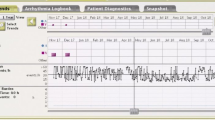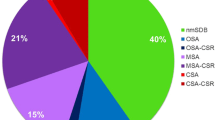Abstract
Previous studies suggested that sleep-disordered breathing was associated with cardiovascular diseases such as heart failure (HF). Recently, algorithms of cardiac implantable electronic devices (CIEDs) have been developed to detect advanced sleep apnea (SA); the Apnea Scan (AP Scan) being an example. The purpose of this study was to investigate the association between respiratory disturbance index (RDI) measured using the AP Scan algorithm and HF development. We retrospectively studied consecutive patients with CIEDs equipped with the AP Scan algorithm which were implanted between December 1, 2011 and March 31, 2019. These patients were divided into 2 groups according to the trends of RDI: patients with a continually high RDI > 30 (severe SA group) and those without a continually high RDI (non-severe SA group). There were 16 and 46 patients in the severe and non-severe SA groups, respectively. Increased left ventricular end-diastolic and end-systolic dimensions were observed in the severe SA group. Regarding cardiovascular events, HF was observed in 8 patients (50.0%) in the severe SA group and 1 patient (2.2%) in the non-severe SA group; thus, there was a significantly higher proportion of patients with HF in the severe SA group. In conclusion, continually high RDI was associated with HF development in patients with CIEDs equipped with the AP Scan algorithm. Therefore, an elevated RDI may be a risk factor for the development of HF in patients with CIEDs.




Similar content being viewed by others
References
Peppard PE, Young T, Palta M, Skatrud J (2000) Prospective study of the association between sleep-disordered breathing and hypertension. N Engl J Med 342:1378–1384
Kanagala R, Murali NS, Friedman PA, Ammash NM, Gersh BJ, Ballman KV, Shamsuzzaman AS, Somers VK (2003) Obstructive sleep apnea and the recurrence of atrial fibrillation. Circulation 107:2589–2594
Bradley TD, Floras JS (2003) Sleep apnea and heart failure: Part I: obstructive sleep apnea. Circulation 107:1671–1678
Bradley TD, Floras JS (2003) Sleep apnea and heart failure: Part II: central sleep apnea. Circulation 107:1822–1826
Lanfranchi PA, Braghiroli A, Bosimini E, Mazzuero G, Colombo R, Donner CF, Giannuzzi P (1999) Prognostic value of nocturnal Cheyne-Stokes respiration in chronic heart failure. Circulation 99:1435–1440
Garrigue S, Pepin JL, Defaye P, Murgatroyd F, Poezevara Y, Clementy J, Levy P (2007) High prevalence of sleep apnea syndrome in patients with long-term pacing: the European Multicenter Polysomnographic study. Circulation 115:1703–1709
Shalaby A, Atwood C, Hansen C, Konermann M, Jamnadas P, Lee K, Willems R, Hartley J, Stahmann J, Kwok J, Ni Q, Neuzner J (2006) Feasibility of automated detection of advanced sleep disordered breathing utilizing an implantable pacemaker ventilation sensor. Pacing Clin Electrophysiol 29:1036–1043
D'Onofrio A, La Rovere MT, Emdin M, Capucci A, Sinagra G, Bianchi V, Pisano ECL, Pieragnoli P, Tespili M, Luzi M, Talarico A, Zecchin M, Rapacciuolo A, Piacenti M, Indolfi C, Arias MA, Diemberger I, Checchinato C, Boriani G, Padeletti L (2018) Implantable cardioverter-defibrillator-computed respiratory disturbance index accurately identifies severe sleep apnea: the DASAP-HF study. Heart Rhythm 15:211–217
Mazza A, Bendini MG, De Cristofaro R, Lovecchio M, Valsecchi S, Boriani G (2017) Pacemaker-detected severe sleep apnea predicts new-onset atrial fibrillation. Europace 19:1937–1943
Tracy CM, Epstein AE, Darbar D, DiMarco JP, Dunbar SB, Estes NAM III, Ferguson TB Jr, Hammill SC, Karasik PE, Link MS, Marine JE, Schoenfeld MH, Shanker AJ, Silka MJ, Stevenson LW, Stevenson WG, Varosy PD (2013) 2012 ACCF/AHA/HRS focused update incorporated into the ACCF/AHA/HRS 2008 guidelines for device-based therapy of cardiac rhythm abnormalities: a report of the American College of Cardiology Foundation/American Heart Association Task Force on Practice Guidelines and the Heart Rhythm Society. J Am Coll Cardiol 61:e6–75
Thygesen K, Alpert JS, Jaffe AS, Chaitman BR, Bax JJ, Morrow DA, White HD (2019) Fourth universal definition of myocardial infarction (2018). Eur Heart J 40:237–269
Sacco RL, Kasner SE, Broderick JP, Caplan LR, Connors JJ, Culebras A, Elkind MS, George MG, Hamdan AD, Higashida RT, Hoh BL, Janis LS, Kase CS, Kleindorfer DO, Lee JM, Moseley ME, Peterson ED, Turan TN, Valderrama AL, Vinters HV (2013) An updated definition of stroke for the 21st century: a statement for healthcare professionals from the American Heart Association/American Stroke Association. Stroke 44:2064–2089
Healey JS, Connolly SJ, Gold MR, Israel CW, Van Gelder IC, Capucci A, Lau CP, Fain E, Yang S, Bailleul C, Morillo CA, Carlson M, Themeles E, Kaufman ES, Hohnloser SH (2012) Subclinical atrial fibrillation and the risk of stroke. N Engl J Med 366:120–129
McKee PA, Castelli WP, McNamara PM, Kannel WB (1971) The natural history of congestive heart failure: the Framingham study. N Engl J Med 285:1441–1446
Linz D, Woehrle H, Bitter T, Fox H, Cowie MR, Bohm M, Oldenburg O (2015) The importance of sleep-disordered breathing in cardiovascular disease. Clin Res Cardiol 104:705–718
Rowley JA, Badr MS (2017) Central sleep apnea in patients with congestive heart failure. Sleep Med Clin 12:221–227
Bucca CB, Brussino L, Battisti A, Mutani R, Rolla G, Mangiardi L, Cicolin A (2007) Diuretics in obstructive sleep apnea with diastolic heart failure. Chest 132:440–446
Bittencourt LR, Suchecki D, Tufik S, Peres C, Togeiro SM, Bagnato MC, Nery LE (2001) The variability of the apnoea–hypopnoea index. J Sleep Res 10:245–251
Moubarak G, Bouzeman A, de Geyer DT, Bouleti C, Beuzelin C, Cazeau S (2017) Variability in obstructive sleep apnea: Analysis of pacemaker-detected respiratory disturbances. Heart Rhythm 14:359–364
Barbieri F, Dichtl W, Heidbreder A, Brandauer E, Stefani A, Adukauskaite A, Senoner T, Schgor W, Hintringer F, Hogl B (2018) Sleep apnea detection by a cardiac resynchronization device integrated thoracic impedance sensor: A validation study against the gold standard polysomnography. PLoS ONE 13:e0195573
Funding
This research received no grant from any funding agency in the public, commercial or not-for-profit sectors.
Author information
Authors and Affiliations
Corresponding author
Ethics declarations
Conflict of interest
The authors declare that they have no conflict of interest.
Additional information
Publisher's Note
Springer Nature remains neutral with regard to jurisdictional claims in published maps and institutional affiliations.
Rights and permissions
About this article
Cite this article
Wakabayashi, Y., Koyama, T., Kurihara, K. et al. Increased respiratory disturbance index measured using an advanced device algorithm is associated with heart failure development. Heart Vessels 35, 817–824 (2020). https://doi.org/10.1007/s00380-019-01551-6
Received:
Accepted:
Published:
Issue Date:
DOI: https://doi.org/10.1007/s00380-019-01551-6




